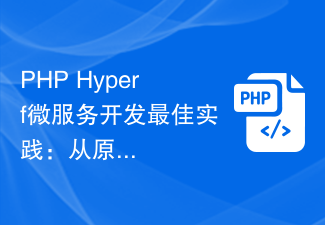 Backend Development
Backend Development PHP Tutorial
PHP Tutorial The key to improving system maintainability and stability: How to develop PHP Hyperf microservices
The key to improving system maintainability and stability: How to develop PHP Hyperf microservices
In today's rapidly developing Internet era, more and more companies or individuals are beginning to pay attention to the maintainability and stability of the system. During the development process, choosing the appropriate development framework has also become crucial. This article will introduce you to a development method that can improve the maintainability and stability of the system-PHP Hyperf microservice development.
First, let’s understand what PHP Hyperf is. PHP Hyperf is a high-performance, highly flexible PHP coroutine framework based on Swoole, focusing on providing powerful support for enterprise-level applications. Compared with the traditional PHP framework, PHP Hyperf adopts an annotation-based development method, which can organize code more efficiently and improve development efficiency.
So, how can PHP Hyperf improve the maintainability and stability of the system?
First of all, PHP Hyperf adopts a microservice-oriented architecture model, splitting the system into multiple independently running services, each service has clear responsibilities and functions. This split method makes the system more modular, and each microservice can be developed, tested and deployed independently, which greatly reduces the coupling between different functional modules. At the same time, when a problem occurs with a service, it can be quickly repaired or replaced, with less impact on the overall system and improving system stability.
Secondly, PHP Hyperf uses annotations for development, which can greatly improve development efficiency. Developers only need to add corresponding annotations to methods or classes to automatically generate relevant configuration and routing information, reducing tedious configuration work and the process of manually adding routes. This way of simplifying the development process allows developers to focus more on the implementation of business logic and improves the maintainability of the code.
In addition, PHP Hyperf also provides a wealth of components and toolkits, which can help developers quickly build various functional modules. For example, PHP Hyperf has built-in functional modules such as database ORM, RPC, cache, message queue, etc. Developers only need to simply configure relevant information to quickly develop. This component-based development approach can improve code reusability and reduce system development and maintenance costs.
In addition, PHP Hyperf also has good fault tolerance. It is based on the characteristics of the Swoole coroutine and can implement error handling and exception capture at the coroutine level to avoid the impact of errors from spreading to the entire system. At the same time, PHP Hyperf has built-in monitoring and logging modules, which can help developers quickly locate and solve problems. This reliable fault-tolerance mechanism and the ability to quickly locate problems greatly improve the stability and maintainability of the system.
To sum up, PHP Hyperf is a development method that can improve the maintainability and stability of the system. It adopts a microservice-oriented architecture model and splits the system into multiple independent services; it uses annotations for development, which simplifies the development process; it provides a wealth of components and toolkits to improve development efficiency; it has good fault tolerance , ensuring the stability of the system. I believe that by using PHP Hyperf for development, we can help companies or individuals build maintainable and stable systems.
The above is the detailed content of The key to improving system maintainability and stability: How to develop PHP Hyperf microservices. For more information, please follow other related articles on the PHP Chinese website!
 win7家庭版与win7旗舰版的区别介绍Jul 12, 2023 pm 08:41 PM
win7家庭版与win7旗舰版的区别介绍Jul 12, 2023 pm 08:41 PM大家都知道win7系统有很多种版本,比如win7旗舰版、win7专业版、win7家庭版等,有不少用户在家庭版和旗舰版之间纠结,不知道选择哪个版本比较好,所以今天小编来跟大家说说win7家庭餐与win7旗舰版的区别介绍,大家一起来看看吧。1、体验不同家庭普通版使您的日常操作变得更快、更简单,可以更快、更方便地访问使用最频繁的程序和文档。家庭高级版让您享有最佳的娱乐体验,可以轻松地欣赏和共享您喜爱的电视节目、照片、视频和音乐。旗舰版集各版本功能之大全,具备Windows7家庭高级版的所有娱乐功能和专
 win11哪个版本最流畅稳定Jan 06, 2024 pm 09:48 PM
win11哪个版本最流畅稳定Jan 06, 2024 pm 09:48 PMwin11整体的操作手感还是很不错的,而且也有很多的版本可以选择和使用,下面就给大家推荐几个非常好用且十分稳定流畅的系统版本,大家可以直接选择下载安装然后使用。win11哪个版本最流畅稳定1、win11原版镜像支持一键备份和恢复服务,无需担心电脑数据误删除等!更快的系统操作和使用特性,让您体验高品质的操作和游戏体验!2、win11系统中文版简单便捷的操作和玩法,让安装系统更简单!多种安全维护工具等你使用,打造更好的系统安全!3、win11俄罗斯大神精简版全面的功能玩法,满足您的各种需求,体验更全
 PHP如何实现自动化测试,提高代码质量和稳定性Jun 27, 2023 am 08:27 AM
PHP如何实现自动化测试,提高代码质量和稳定性Jun 27, 2023 am 08:27 AM在现代软件开发过程中,自动化测试已成为了保证软件质量和稳定性的必要手段之一。其中,针对PHP开发的自动化测试技术更是越来越成熟和广泛应用。本文将从自动化测试的基本概念入手,讲解PHP自动化测试的实现方式和应用场景,以及如何通过自动化测试来提高代码质量和稳定性。一、自动化测试简介自动化测试是指将软件测试过程中繁琐、耗时的任务通过程序自动化实现,包括测试用例的
 麒麟9000s性能究竟如何?Mar 22, 2024 pm 03:21 PM
麒麟9000s性能究竟如何?Mar 22, 2024 pm 03:21 PM作为一款备受关注的旗舰手机,麒麟9000s一经推出便引起了广泛的讨论和关注。它搭载了麒麟9000系列最新的旗舰芯片,性能堪称强劲。那么,麒麟9000s的性能究竟如何?让我们一起来探讨。首先,麒麟9000s采用了全新的5nm工艺制造,极大提升了芯片的性能和功耗控制。与之前的麒麟处理器相比,麒麟9000s在性能上有着明显的提升。无论是运行大型游戏、多任务处理还是
 Scrapy如何提高爬取稳定性和抓取效率Jun 23, 2023 am 08:38 AM
Scrapy如何提高爬取稳定性和抓取效率Jun 23, 2023 am 08:38 AMScrapy是一款Python编写的强大的网络爬虫框架,它可以帮助用户从互联网上快速、高效地抓取所需的信息。然而,在使用Scrapy进行爬取的过程中,往往会遇到一些问题,例如抓取失败、数据不完整或爬取速度慢等情况,这些问题都会影响到爬虫的效率和稳定性。因此,本文将探讨Scrapy如何提高爬取稳定性和抓取效率。设置请求头和User-Agent在进行网络爬取时,
 基于PHP Hyperf的微服务开发最佳实践与优化方法Sep 11, 2023 pm 01:40 PM
基于PHP Hyperf的微服务开发最佳实践与优化方法Sep 11, 2023 pm 01:40 PM基于PHPHyperf的微服务开发最佳实践与优化方法随着云计算和分布式架构的迅速发展,微服务架构已经成为了越来越多企业和开发者的首选。而作为PHP生态中的一颗新星,PHPHyperf框架以其轻量、高性能和灵活的特点,成为了众多开发者进行微服务开发的选择。本文将介绍基于PHPHyperf的微服务开发的最佳实践和优化方法,帮助开发者更好地应对实际项目中的挑
 PHP Hyperf微服务开发最佳实践:从原型到生产环境Sep 12, 2023 am 10:36 AM
PHP Hyperf微服务开发最佳实践:从原型到生产环境Sep 12, 2023 am 10:36 AMPHPHyperf是一款高性能的微服务框架,被广泛应用于大型互联网公司的开发中。本文将介绍如何使用PHPHyperf进行微服务开发的最佳实践,从原型到生产环境。一、环境准备在开始使用PHPHyperf进行微服务开发之前,需要进行环境准备。首先,确保已经安装了PHP的运行环境,并且版本为7.2以上。其次,安装Composer,用于管理PHP依赖包。最后,
 深度解析Linux为何稳定如山:技术与哲学的结合之道Mar 14, 2024 am 11:33 AM
深度解析Linux为何稳定如山:技术与哲学的结合之道Mar 14, 2024 am 11:33 AM标题:深度解析Linux为何稳定如山:技术与哲学的结合之道Linux作为开源操作系统的代表之一,以其稳定性和强大的功能受到广泛赞誉。许多人对Linux系统之所以如此稳定兴趣浓厚,这背后是技术与哲学的结合之道。本文将从技术和哲学两个角度深入分析Linux系统的稳定性,并通过具体代码示例来展示。技术层面上,Linux系统之所以稳定如山,一方面源自于其设计的精巧和


Hot AI Tools

Undresser.AI Undress
AI-powered app for creating realistic nude photos

AI Clothes Remover
Online AI tool for removing clothes from photos.

Undress AI Tool
Undress images for free

Clothoff.io
AI clothes remover

AI Hentai Generator
Generate AI Hentai for free.

Hot Article

Hot Tools

Dreamweaver Mac version
Visual web development tools

MantisBT
Mantis is an easy-to-deploy web-based defect tracking tool designed to aid in product defect tracking. It requires PHP, MySQL and a web server. Check out our demo and hosting services.

Notepad++7.3.1
Easy-to-use and free code editor

SAP NetWeaver Server Adapter for Eclipse
Integrate Eclipse with SAP NetWeaver application server.

SublimeText3 Mac version
God-level code editing software (SublimeText3)





